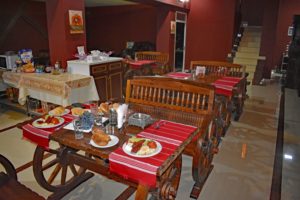Jerez is justly famous, but a 45-minute bus ride away – cheap at 2 Euros single – Arcos de la Frontera is worth more than a day trip. It is the most westerly of the “White towns” of Andalucia and unlike, say, Frigiliana, it is a lively working town.
Most of the everyday work is done in the lower town; the upper, old area bears mention in the same breath with Cuenca or even Ronda. The way up is steep, becoming narrow, yet minibuses will carry those who need them from the bus station to the high plaza. On foot though you access, if only to the portico, the ancestral homes of local gentry. Each is an architectural gem, its doorway crowned with a coat of arms. There is also San Miguel, an Islamic fortification converted to Christian church, just as the road begins to to rise.
Restaurants and bars abound, naturally, but they do not dominate. The tourist office is reached by steep steps but the staff are very helpful, handing out maps that show all the places to see with brief notes on their history. There are two major churches: San Pedro and Santa Maria de la Asuncion, facing a plaza and viewpoint but also adjacent to the Parador that will serve wine or coffee at only just above local prices and give you the pleasure of its terrace on the cliff top. If you wish to splash out it has a restaurant. To stay overnight costs 100 Euros.
For garden lovers there is the Jardin Andaluz, reached by going through the mayoral palace, which also has a bar and serves light meals. We first thought the garden was out of reach, but fortunately saw some people on a balcony looking down on it. Later we acted in the same way for others who seemed locked out by the enclosing walls. It is a beautifully kept space of varied green shrubs and water, fountains and rills. At one end is a vine that must be wonderful in summer. The walls are decorated with roundels and other shapes in tile, almost the only colour in the garden. It is a place to sit in and contemplate.
The mayoral palace is an elegant building, well worth visiting in its own right, with a small museum of printing in honour of some local authors. There was also, during our visit, a display of posters and photographs of “The Three Cornered Hat” ballet and more featuring Antonio, who will be recalled by Silver Travellers with an interest in Spanish dance.
The viewpoints are numerous and magnificent, almost as dramatic as at Ronda and with more variety. No eagles, but we saw hobbies chasing around the sky from the tower of San Pedro. There are also views of the clifftop to compare with Cuenca. Anyone who stays there for a couple of days – and it is worthwhile – can explore the eastern part of Arcos, which still has the remains of its gate (the western was demolished to assist traffic movement) and several other features. There is also the lake (actually a reservoir) used by locals for swimming. The Guadalquivir river loops around the town.
Numerous restaurants offer perfectly good meals for 10 Euros or less, so there’s no need to break the bank. Wine is included. Local specialities are very tasty. Arcos even has a cheese festival in April.















